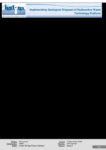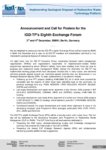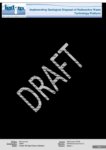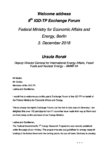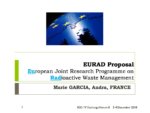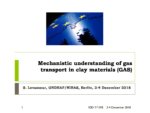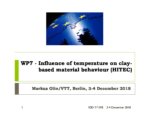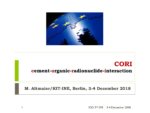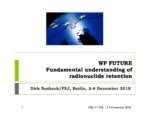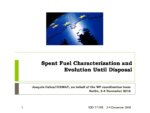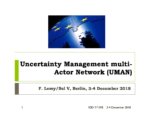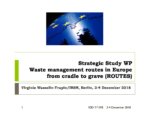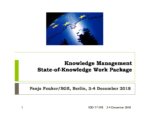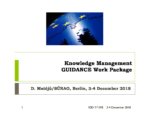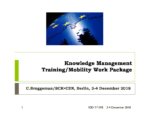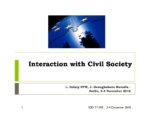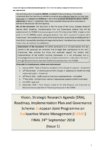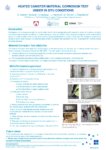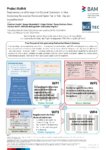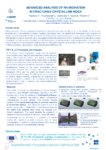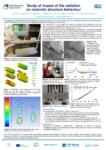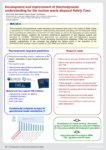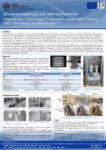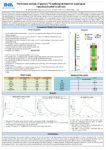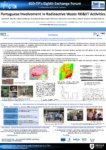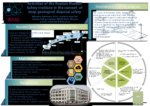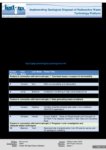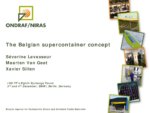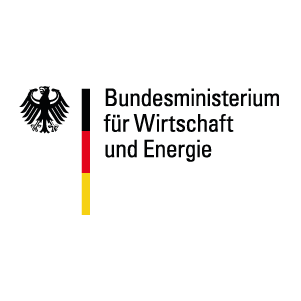IGD-TP Exchange Forum 8
3rd December 2018 to 4th December 2018
German Federal Ministry for Economic Affairs and Energy (BMWi),
Invalidenstraße 48,
10115 Berlin,
Germany
View on Google MapsThe IGD-TP’s eighth Exchange Forum (EF8) was a great success with over 140 attendees from 21 different countries. Our host, BMWi, provided a superb venue and welcoming environment that facilitated an excellent array of presentations and a great deal of discussion and networking. A brief summary of the scope, objectives and outcomes of EF8 is provided here, along with copies of the presentations and available posters.

Introduction
For almost ten years now the IGD-TP Executive Group, comprising European waste management organisations (WMOs) and organisations responsible for implementation-related RD&D programmes representing eleven different nations, have been meeting three times per year to progress joint radioactive waste management RD&D. During this timeframe the IGD-TP has implemented working groups which have discussed, initiated and, in many cases, now delivered technical projects aligned around our commonly-agreed priorities that are documented in our Strategic Research Agenda (SRA). To date, achievements of our platform include:
- Following up nine FP7 projects (totalling 61M€/28M€ EC) all of which have successfully completed and the majority of which have been debriefed back to the community via previous exchange fora (e.g. PEBS, MODERN, FIRST-NUCLIDES, REDUPP, BELBaR, DOPAS and LUCOEX);
- Led scope development and needs driven alignment of four Horizon 2020 projects in WP 2014-2015 (MODERN2020, CEBAMA, MIND and JOPRAD), totalling 21M€/15M€ EC funding;
- Led scope development and needs driven alignment of a further four Horizon 2020 projects in WP 2016-2017 (~16M€ EC funding), which started in June 2017 (THERAMIN, BEACON, DISCO and CHANCE).
- Contributed towards the scope development and needs driven alignment of many of the developing European Joint Programme Work packages, particularly GAS, CORI, HITEC, SFC, UMAN and ROUTES.
Objectives and Scope
EF8 was a two-day event with a dual focus. The first day was dedicated to the European Joint Programme on Radioactive Waste Management (EURAD). Representatives of the proposed future EURAD Project Management Office (PMO) led sessions dedicated to:
- Presenting the R&D topics, strategic studies and knowledge management activities that comprise the initial scope of EURAD.
- Presenting the shared EURAD Strategic Research Agenda (SRA) and its future development.
- Updating the community on the expected EURATOM Call WP2019-2020.
The change to a Joint Programme approach for EC-funded research means that the IGD-TP Executive Group will now focus more intently on direct implementation-related opportunities for collaboration between members and their common research needs that sit outside of the scope of the EURAD programme and its governing SRA. Therefore, the IGD-TP Executive Group led sessions on the second day of EF8 that aimed to:
- Communicate the changing needs and drivers for radioactive waste management research (in light of the complimentary and parallel EURAD project).
- Update IGD-TP members on the platform’s activities during 2017 and 2018.
- Collectively explore collaborative opportunities for implementation-related research projects that are complementary, but separate to, the common areas of interest being addressed via EURAD. Initially, for EF8, this was undertaken by discussing the current status, challenges and potential solutions in three specific technical topic areas in dedicated parallel breakout sessions.
We structured the event to act as a transition between the previous IGD-TP Exchange Forums and our traditional way of operating (i.e. working groups to develop scope for future EC calls) to our future revised remit, following the expected initiation of an inclusive and enduring European Joint Programme in the area of radioactive waste management.
The main IGD-TP aim of EF8 was to help to prepare for future collaborative implementation-related RD&D that is complimentary to EURAD activities and which can be progressed in parallel.
Summary and Outcomes
Day 1 - Led by EURAD PMO Representatives
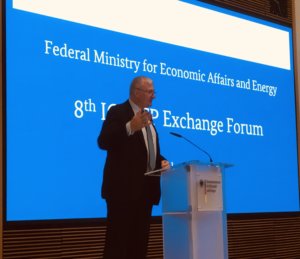 Following the welcome from the IGD-TP Chair, Jon Martin (RWM), Ursula Borak of BMWi gave an excellent summary of the national radioactive waste management policy and its implementation in Germany.
Following the welcome from the IGD-TP Chair, Jon Martin (RWM), Ursula Borak of BMWi gave an excellent summary of the national radioactive waste management policy and its implementation in Germany.
Christophe Davies (EC) then presented initial EC views of the EURAD proposal, summarised the current status of the EURATOM programme, and highlighted that a Euratom Call is 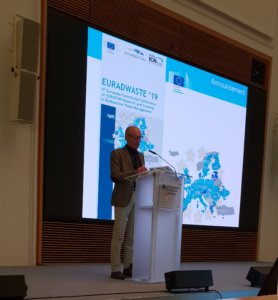 expected this year on “Developing pre-disposal activities identified in the scope of the European Joint Programme in RWM” (proposal submission will be September 2019). It was also announced that EURADWASTE’19 will be held on 4-7 June 2019 in Pitesti, Romania, which will be the 9th EC conference on EURATOM research and training in radioactive waste management.
expected this year on “Developing pre-disposal activities identified in the scope of the European Joint Programme in RWM” (proposal submission will be September 2019). It was also announced that EURADWASTE’19 will be held on 4-7 June 2019 in Pitesti, Romania, which will be the 9th EC conference on EURATOM research and training in radioactive waste management.
The remainder of the Day 1 presentations then informed EF8 attendees on the scope and objectives of the propo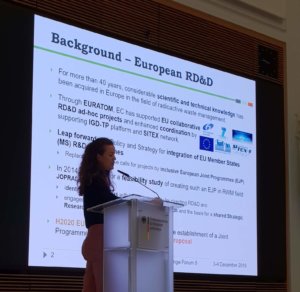 sed EURAD project. This commenced with an overview of EURAD and its organisation by Marie Garcia (Andra), and was then followed by presentations on each of the seven RD&D work packages, the two strategic study work packages, the knowledge management activities and the anticipated interactions with civil society. The EURAD session then concluded with a summary of the current status of the EURAD SRA and its future development by Tara Beattie (MCM), and presentations by representatives of each of the three proposed EURAD Colleges, one each for the research entities (REs), technical service organisations (TSOs) and the WMOs.
sed EURAD project. This commenced with an overview of EURAD and its organisation by Marie Garcia (Andra), and was then followed by presentations on each of the seven RD&D work packages, the two strategic study work packages, the knowledge management activities and the anticipated interactions with civil society. The EURAD session then concluded with a summary of the current status of the EURAD SRA and its future development by Tara Beattie (MCM), and presentations by representatives of each of the three proposed EURAD Colleges, one each for the research entities (REs), technical service organisations (TSOs) and the WMOs.

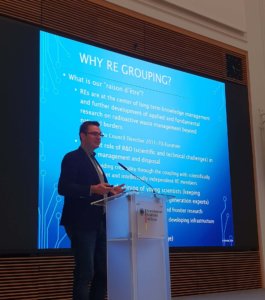
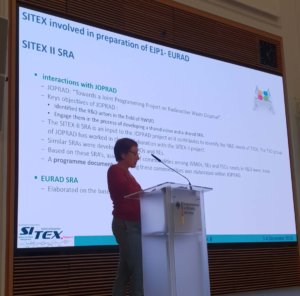
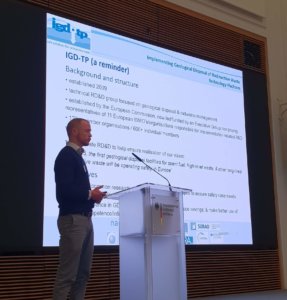
Poster Session
Following the end of the EURAD day, an informative and lively poster session was held. 28 posters were presented covering the range of the IGD-TP SRA, with 15 posters directly connected with the three IGD-TP technical topics (see below). The poster titles and abstracts are available here and, where available, copies of the posters can be downloaded from the event documents section below.
Day 2 - Led by the IGD-TP Executive Group
T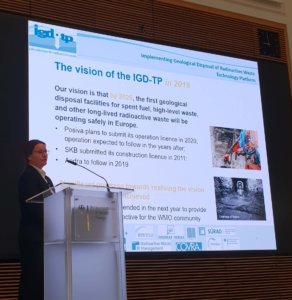 he second day was chaired by the IGD-TP Executive Group. The incoming IGD-TP Chair, Irina Gaus (Nagra), reflected on the current research needs of the IGD-TP, achievement of our vision, how the IGD-TP and its relationship with the EURATOM programme has changed and the needs and drivers of WMO research programmes. She then focussed on the changing role and remit of the IGD-TP and our next steps.
he second day was chaired by the IGD-TP Executive Group. The incoming IGD-TP Chair, Irina Gaus (Nagra), reflected on the current research needs of the IGD-TP, achievement of our vision, how the IGD-TP and its relationship with the EURATOM programme has changed and the needs and drivers of WMO research programmes. She then focussed on the changing role and remit of the IGD-TP and our next steps.
Jon Martin (RWM) discussed the preliminary list of RD&D topics identified by the Executive Group that are of interest to WMOs but are outside the scope of the EURAD project – such topics may be outside the current and future scope of EURAD for many reasons, for example:
- The scope is such that it would be inappropriate to collaborate with regulatory bodies due to a perceived conflict of interest.
- The topic area/scope of interest did not gain consensus with other EURAD actor groups (i.e. the topic is not of sufficient common interest).
- The required work is too time critical to be addressed by the ongoing joint programme.
- The required work is of WMO interest/significance, but is not deemed to be sufficiently cutting edge for inclusion in a EURATOM-funded project.
For EF8 the Executive Group selected three topics from the list to focus on in dedicated break-out sessions. The scope of each topic session and the session outcomes, as presented to the full EF8 audience, are summarised below.
Technical topic 1: “Technical issues in support of retrievability”
Retrievability of waste packages can be provided to support operational safety, more particularly in accidental situations. Regardless of operational safety needs, it may also be a regulatory requirement in a number of national programmes, potentially incorporating consideration of some aging. This session addressed scientific and technical knowledge and potential issues associated with the implementation of retrievability as well as related RD&D drivers. This included the ability to model and monitor the evolution of waste packages and disposal rooms over time during the operating period, the technical provisions that can be included in the design to enhance retrievability, and the retrieval techniques.
Jean-Michel Hoorelbeke (Andra) summarised the presentations and discussions held in Technical Session 1. Four presentations were given by representatives from Andra, BGE TEC, RWM and SKB, which demonstrated international experience in:
- removal of concrete buffer (UK);
- removal of bentonite backfill and buffer (Sweden);
- removal of salt or other material (Germany); and
- retrieval of waste packages (France; Germany; Sweden).
The associated technical discussion considered:
- buffer, plugs, seals and backfill removal techniques;
- retrieval techniques for waste packages in disposal cells;
- knowledge of the phenomenological state of disposal cells;
- management of contamination and/or activation products, if any; and
- lessons that could be learned on technical aspects from dismantling.
It was noted that the current state of the art within the field of GDF and dismantling can be used widely, and that retrievability needs more engineering studies (potentially in the form of demonstrators) rather than R&D. It was also agreed that the design of the retrieval procedure needs to be adapted to account for:
- national requirements, from the mitigation of incidental situations (as required in Sweden) to broader reversibility/retrievability legal/regulatory requirements (required in France and Germany);
- the type of host rock;
- the radioactive waste inventory; and
- the conceptual design of the disposal facility (e.g. geometry, material, schedule, length of operating period, etc.).
A number of safeguards and safety issues remain to be addressed, which need further information exchange at the international level. These issues include:
- retrieval in a nuclear environment;
- how to deal with removed contaminated material;
- how to safely reopen retrieved waste packages;
- operational safety during retrieval; and
- the definition of safety scenarios leading to retrieval situations
Three next steps were identified in the technical session:
- To collate and formalise the current state of the art to form a technological toolbox to support international knowledge sharing;
- To progress and share information on retrievability scenarios and risk analysis; and
- To assess the possibility of a common demonstrator programme within EURAD2 or the IGD-TP.
Technical topic 2: “Heat generating waste containers”
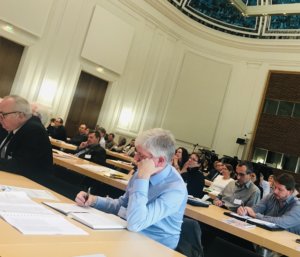 This technical topic focussed on reviewing the technology readiness and development of alternative ‘next generation’ disposal container materials/designs. The aim for the session was to help to support concept selection/development for earlier stage disposal programmes and also concept optimisation for the more advanced disposal programme concepts. The session aim was to highlight the state-of-the-art in container materials and design, covering ceramic containers, supercontainer concepts and alternative candidate container materials. The session objective was to develop areas of commonality in terms of future WMO RD&D needs.
This technical topic focussed on reviewing the technology readiness and development of alternative ‘next generation’ disposal container materials/designs. The aim for the session was to help to support concept selection/development for earlier stage disposal programmes and also concept optimisation for the more advanced disposal programme concepts. The session aim was to highlight the state-of-the-art in container materials and design, covering ceramic containers, supercontainer concepts and alternative candidate container materials. The session objective was to develop areas of commonality in terms of future WMO RD&D needs.
Michelle Cowley (RWM) reported back that this session included extensive representation from WMOs, very helpful contributions from TSOs and active contributions from REs, and had representatives from 12 countries.
Three presentations were provided by WMO representatives, covering ceramic containers (Nathalie Texier-Mandoki, Andra), coated containers (Nikitas Diomidis, Nagra) and supercontainers (Séverine Levasseur, ONDRAF/NIRAS), with active discussion following each presentation.
Discussion regarding ceramic containers noted that:
- ceramic technology is less mature and its key vulnerability is its mechanical properties;
- a key advantage for a clay geological environment is that ceramic containers do not generate gases as they corrode;
- the corrosion rate is extremely slow;
- there is limitation on container length with currently available technology, which may impact use as a container for SF;
- container closure is being actively investigated using a variety of thermal techniques;
- no inspection technologies were identified;
- nuclear waste disposal is the only area of industry which appears to have a requirement for ceramic components of this scale;
- there was interest in continued collaboration in this area, particularly in conjunction with container coatings research.
The container coatings discussion covered:
- there are a number of materials available for coating containers (e.g. Cu, Ni, Ti, metal alloys and ceramics)
- containers require careful handling to ensure the coating remains intact;
- there are potential sustainability benefits through reduced use of particular materials;
- container closure is the main limitation and would require more research;
- other limitations include repair of coatings and inspection techniques;
- the cost of some coatings can be relatively high;
- coated containers are still susceptible to corrosion issues seen with single metal containers, but the behaviour can be more predictable;
- BEP Surface Technologies offered to host a meeting to discuss areas for collaboration.
The supercontainer discussion covered:
- the key driver for the supercontainer concept is operational safety;
- there are predictability and quality control benefits to using industry-standard products over natural products;
- the main limitation is keeping cement intact as the package is transported and emplaced;
- supercontainers improve shielding in the operational phase;
- sharing of knowledge is beneficial as the broad concept has potential, but its national implementation is driven by requirements of specific geological environments;
- there is less potential for collaborative RD&D.
The session concluded that:
- ceramics are promising but represent a significant challenge due to their low technology readiness level (TRL);
- the opportunity to drive ceramics development forward at pace is through industry collaboration;
- there is an opportunity to create adaptable designs;
- understanding other factors (e.g. heat, legal requirements) also needs to be considered in container development;
- coated containers were considered to be the most transferrable across different host rocks;
- the majority of the session attendees were supportive of further discussion on container coatings;
- an action was agreed to hold a follow-up meeting (hosted by BEP Surface Technologies) to discuss concepts that include ceramics and coated containers.
Technical topic 3: “Progress in site investigation and characterisation techniques”
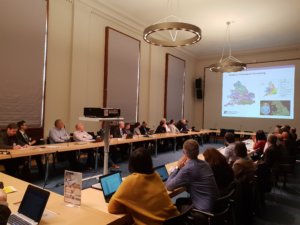
A geological disposal site characterisation programme will need to meet the information requirements of the design and disposal system safety assessments and also contribute towards the development of a site descriptive model. Typically, a site characterisation team will need to define the parameters to be measured to provide this information. This technical session sought to address advanced site characterisation techniques. It covered investigation and modelling of the biosphere and geosphere according to typical higher-strength rock and lower-strength sedimentary rock repository requirements. It also addressed the process for site selection before and after advanced site characterisation, and site characterisation during construction and operational phases. This technical session sought to address aspects of advanced site characterisation techniques and identify topics for potential knowledge transfer towards emerging programs.
As summarised by Bernd Frieg (Nagra), this session included five presentations on site characterisation in national programmes across the spectrum of GDF implementation stages:
- Hungary / Peter Molnar (Puram) – Site characterisation in the Hungarian early-stage programme;
- UK / Rob McLaverty (RWM) – Preparation for site characterisation in the UK: a needs-driven exercise;
- Switzerland / Bernd Frieg (Nagra) – Site characterisation in the final stage of selecting the site in sedimentary clay rock in Switzerland;
- Sweden / Peter Wikberg (SKB) – Site characterisation in the Swedish crystalline rock before and after submitting the construction licence;
- France / Jacques Delay (Andra) – Site characterisation in the French sedimentary/clay rock programme, close to construction licence submission.
The discussion and questions raised were found to focus on a number of themes:
Methodological topics for site selection
- With regard to shared disposal options for countries with small inventories there would be a need for international siting investigations – how can such collaboration be realised?
- Public participation: how to make it successful? The NEA IGSC (International Group for Safety Case) already has efforts in place.
- When managing a siting programme, what were the motivating factors to move to the next stage (e.g. from desk-based to surface to intrusive investigation)? Is the schedule a key element, the information gained or interaction with the local community?
Site characterisation topics
- It would be helpful to bring together in a more comprehensive way the lessons learned from site investigations for construction (e.g. ramp and shaft construction) and accompanying monitoring (e.g. Andra, SKB).
- WMOs have implanted requirement-driven approaches from the safety case and geology -based approaches. It was questioned what a programme needs to know and when: what justifies the decision used?
- Strategy of limited extensive deep boreholes (e.g. Nagra) versus multiple boreholes with limited objectives (e.g. Andra) – what are the drivers for the implemented strategies?
Timing questions of programme elements for site selection
- At which characterisation stage should the inventory be defined?
- How does the inventory affect the footprint of the facility?
- At which stage must the waste package be defined?
- At which stage does the location of the site-specific URL need to be defined?
RD&D topics
- Research for offshore scenario development (RWM).
- Use of the URLs in foreign countries to gain experience (e.g. Andra experience / Mt. Terri).
- How do we identify what is new in site investigations?
- Do we need to do more on driving technological development for siting?
Management topics
- Practicalities how the safety case and site description are linked.
- Need to establish the appropriate workflows.
- How to ensure data management (i.e large data sets that must be safely stored and accessible for decades)?
- Permanent re-evaluation of own approaches – build-up of a learning organisation actively and working physically together.
Technical Session 3 concluded that knowledge transfer is the key area to develop in the future, but this first needs the requirements to be refined by those planning to use the knowledge. Possible options suggested to enable knowledge transfer included secondments in more advanced programmes, holding workshops, creating an expert network, and web-based activities (e.g. webinars, platform discussions, WhatsApp groups). It was recommended that knowledge transfer in the area of site characterisation and investigation is a topic addressed in the EURAD knowledge management activities.
Following feedback from each of the technical sessions, Irina Gaus led a panel discussion on linking WMO RD&D programmes at different stages with the IGD-TP. To initiate discussion, presentations were given on five national WMO programmes at various stages, summarising their current programme stage, highest RD&D priorities and their RD&D drivers:
- Denmark, representing an early stage programme that is not currently an IGD-TP member (Ole Kastbjerg, DEKOM);
- The Netherlands, representing an early stage programme (Jeroen Bartol, COVRA);
- Switzerland, a mid-stage programme (Irina Gaus, Nagra);
- Sweden, an advanced-stage programme (Peter Wikberg, SKB); and
- Finland, an advanced-stage programme (also presented by Peter Wikberg).
The discussion focussed on how knowledge can be maintained and transferred over the long lead times and operational periods expected for the various national programmes, and how much and what RD&D is needed at each programme stage. The point was also made that knowledge transfer is necessary between advanced national programmes, as well as between advanced and small/early-stage programmes. It was suggested that the IGD-TP could help to record and collaboratively share information between WMOs to ensure it is not lost, particularly as issues may be considered closed and then reopened in the future.
Following active and informative discussion over the two days, EF8 was closed by Jon Martin, with thanks to all the presenters, organisers and our host, BMWi.
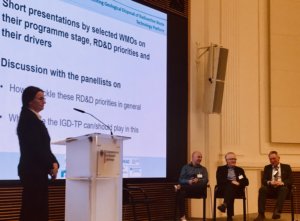
Further Information
For any queries please contact secretariat@igdtp.eu
Related Documents
IGD-TP Exchange Forum 8 – Agenda
Description: IGD-TP Exchange Forum 8 - Agenda (27 November 2018)
Last updated: November 27, 2018
IGD-TP Exchange Forum 8 – Agenda and Attendee List
Description: IGD-TP Exchange Forum 8 - Agenda and Attendee List (29 November 2018)
Last updated: November 29, 2018
IGD-TP Exchange Forum 8 – First Announcement
Description: IGD-TP Exchange Forum 8 - First Announcement (12 July 2018)
Last updated: July 12, 2018
IGD-TP Exchange Forum 8 – Second Announcement
Description: IGD-TP Exchange Forum 8 - Second Announcement (12 September 2018)
Last updated: September 12, 2018
IGD-TP Exchange Forum 8 – Third Announcement
Description: IGD-TP Exchange Forum 8 - Third Announcement (29 October 2018)
Last updated: October 29, 2018
IGD-TP Exchange Forum 8 – Day 1 (EURAD) 0900 – Jon Martin – Opening Session
Description: IGD-TP Exchange Forum 8 (Dec 2018) - Day 1 (EURAD) Presentations - 0900 - Jon Martin - Opening Session
Last updated: December 7, 2018
IGD-TP Exchange Forum 8 – Day 1 (EURAD) 0915 – Ursula Borak – Welcome Address
Description: IGD-TP Exchange Forum 8 (Dec 2018) - Day 1 (EURAD) Presentations - 0915 - Ursula Borak - Welcome Address (transcript)
Last updated: January 11, 2019
Description: IGD-TP Exchange Forum 8 (Dec 2018) - Day 1 (EURAD) Presentations - 0930 - Christophe Davies - Euratom Programme (2014-2018/2019-20) - Status
Last updated: December 7, 2018
IGD-TP Exchange Forum 8 – Day 1 (EURAD) 0940 – Marie Garcia – EURAD Overview and Organisation
Description: IGD-TP Exchange Forum 8 (Dec 2018) - Day 1 (EURAD) Presentations - 0940 - Marie Garcia - EURAD Overview and Organisation
Last updated: December 7, 2018
Description: IGD-TP Exchange Forum 8 (Dec 2018) - Day 1 (EURAD) Presentations - 1010 - Francis Claret - RD&D WP: Development and Improvement Of NUmerical methods and Tools for modelling coupled processes (DONUT)
Last updated: December 7, 2018
Description: IGD-TP Exchange Forum 8 (Dec 2018) - Day 1 (EURAD) Presentations - 1030 - Alexandre Dauzeres - RD&D WP: Assessment of Chemical Evolution of ILW and HLW Disposal Cells (ACED)
Last updated: December 7, 2018
Description: IGD-TP Exchange Forum 8 (Dec 2018) - Day 1 (EURAD) Presentations - 1050 - Séverine Levasseur - RD&D WP: Mechanistic understanding of gas transport in clay materials (GAS)
Last updated: December 7, 2018
Description: IGD-TP Exchange Forum 8 (Dec 2018) - Day 1 (EURAD) Presentations - 1140 - Markus Olin - RD&D WP: Influence of temperature on clay-based material behaviour (HITEC)
Last updated: December 7, 2018
Description: IGD-TP Exchange Forum 8 (Dec 2018) - Day 1 (EURAD) Presentations - 1200 - Marcus Altmaier - RD&D WP: Cement-Organics-Radionuclides-Interactions (CORI)
Last updated: December 7, 2018
Description: IGD-TP Exchange Forum 8 (Dec 2018) - Day 1 (EURAD) Presentations - 1220 - Dirk Bosbach - RD&D WP: Fundamental understanding of radionuclide retention (FUTuRE)
Last updated: December 7, 2018
Description: IGD-TP Exchange Forum 8 (Dec 2018) - Day 1 (EURAD) Presentations - 1240 - Joaquín Cobos - RD&D WP: Spent Fuel Characterization and Evolution Until Disposal (SFC)
Last updated: December 7, 2018
Description: IGD-TP Exchange Forum 8 (Dec 2018) - Day 1 (EURAD) Presentations - 1430 - Frank Lemy - SS WP: Uncertainty Management multi-Actor Network (UMAN)
Last updated: December 7, 2018
Description: IGD-TP Exchange Forum 8 (Dec 2018) - Day 1 (EURAD) Presentations - 1450 - Virginie Wasselin - SS WP: Waste management routes in Europe from cradle to grave (ROUTES)
Last updated: December 7, 2018
IGD-TP Exchange Forum 8 – Day 1 (EURAD) 1510a – Gunnar Buckau – Knowledge Management Activities
Description: IGD-TP Exchange Forum 8 (Dec 2018) - Day 1 (EURAD) Presentations - 1510a - Gunnar Buckau - Knowledge Management Activities
Last updated: December 7, 2018
IGD-TP Exchange Forum 8 – Day 1 (EURAD) 1510b – Panja Feuker – State of Knowledge WP
Description: IGD-TP Exchange Forum 8 (Dec 2018) - Day 1 (EURAD) Presentations - 1510b - Panja Feuker - State of Knowledge WP
Last updated: December 7, 2018
IGD-TP Exchange Forum 8 – Day 1 (EURAD) 1510c – Dalibor Mateju – Guidance WP
Description: IGD-TP Exchange Forum 8 (Dec 2018) - Day 1 (EURAD) Presentations - 1510c - Dalibor Mateju - Guidance WP
Last updated: December 7, 2018
IGD-TP Exchange Forum 8 – Day 1 (EURAD) 1510d – Christophe Bruggeman – Training WP
Description: IGD-TP Exchange Forum 8 (Dec 2018) - Day 1 (EURAD) Presentations - 1510d - Christophe Bruggeman - Training WP
Last updated: December 7, 2018
IGD-TP Exchange Forum 8 – Day 1 (EURAD) 1550 – Julien Dewogélhaëre – Interaction with Civil Society
Description: IGD-TP Exchange Forum 8 (Dec 2018) - Day 1 (EURAD) Presentations - 1550 - Julien Dewogélhaëre - Interaction with Civil Society
Last updated: December 7, 2018
Description: IGD-TP Exchange Forum 8 (Dec 2018) - Day 1 (EURAD) Presentations - 1600a - Tara Beattie - EURAD Strategic Research Agenda and its Future Development
Last updated: December 7, 2018
IGD-TP Exchange Forum 8 – Day 1 (EURAD) 1600b – Rob Winsley – WMO College (IGD-TP)
Description: IGD-TP Exchange Forum 8 (Dec 2018) - Day 1 (EURAD) Presentations - 1600b - Rob Winsley - WMO College (IGD-TP)
Last updated: December 7, 2018
IGD-TP Exchange Forum 8 – Day 1 (EURAD) 1600c – Elisabeth Salat – TSO College (SITEX)
Description: IGD-TP Exchange Forum 8 (Dec 2018) - Day 1 (EURAD) Presentations - 1600c - Elisabeth Salat - TSO College (SITEX)
Last updated: December 7, 2018
IGD-TP Exchange Forum 8 – Day 1 (EURAD) 1600d – Christophe Bruggeman – RE College
Description: IGD-TP Exchange Forum 8 (Dec 2018) - Day 1 (EURAD) Presentations - 1600d - Christophe Bruggeman - RE College
Last updated: December 7, 2018
IGD-TP Exchange Forum 8 – Day 2 (IGD-TP) 0845 – Jon Martin – Opening Session
Description: IGD-TP Exchange Forum 8 (Dec 2018) - Day 2 (IGD-TP) Presentations - 0845 - Jon Martin - Opening Session
Last updated: December 7, 2018
IGD-TP Exchange Forum 8 – Day 2 (IGD-TP) 0900 – Irina Gaus – Planning for the IGD-TP’s second decade
Description: IGD-TP Exchange Forum 8 (Dec 2018) - Day 2 (IGD-TP) Presentations - 0900 - Irina Gaus - Planning for the IGD-TP’s second decade
Last updated: December 7, 2018
Description: IGD-TP Exchange Forum 8 (Dec 2018) - Day 2 (IGD-TP) Presentations - 0915 - Jon Martin - WMO areas of interest outside of the EURAD scope
Last updated: December 7, 2018
Description: IGD-TP Exchange Forum 8 (Dec 2018) - Day 2 (IGD-TP) Presentations - 1430 - Jean-Michel Hoorelbecke - Technical Session Summary – 1: Technical issues in support of retrievability
Last updated: December 7, 2018
Description: IGD-TP Exchange Forum 8 (Dec 2018) - Day 2 (IGD-TP) Presentations - 1500 - Michelle Cowley - Technical Session Summary – 2: Heat Generating Waste Containers
Last updated: December 7, 2018
Description: IGD-TP Exchange Forum 8 (Dec 2018) - Day 2 (IGD-TP) Presentations - 1530 - Bernd Frieg - Technical Session Summary – 3: Progress in site investigation and characterisation techniques
Last updated: December 7, 2018
Description: IGD-TP Exchange Forum 8 (Dec 2018) - Day 2 (IGD-TP) Presentations - 1600a - Irina Gaus - Panel Discussion: Linking WMO RD&D programmes in different stages with the IGD-TP
Last updated: December 7, 2018
Description: IGD-TP Exchange Forum 8 (Dec 2018) - Day 2 (IGD-TP) Presentations - 1600b - Ole Kastbjerg - Panel Discussion: Danish WMO RD&D Perspective
Last updated: December 7, 2018
Description: IGD-TP Exchange Forum 8 (Dec 2018) - Day 2 (IGD-TP) Presentations - 1600c - Jeroen Bartol - Panel Discussion: The Netherlands WMO RD&D Perspective
Last updated: December 7, 2018
Description: IGD-TP Exchange Forum 8 (Dec 2018) - Day 2 (IGD-TP) Presentations - 1600d - Irina Gaus - Panel Discussion: Swiss WMO RD&D Perspective
Last updated: December 7, 2018
Description: IGD-TP Exchange Forum 8 (Dec 2018) - Day 2 (IGD-TP) Presentations - 1600e - Peter Wikberg (SKB on behalf of Posiva) - Panel Discussion: Finnish WMO RD&D Perspective
Last updated: December 7, 2018
Description: IGD-TP Exchange Forum 8 (Dec 2018) - Day 2 (IGD-TP) Presentations - 1600f - Peter Wikberg - Panel Discussion: Swedish WMO RD&D Perspective
Last updated: December 7, 2018
IGD-TP Exchange Forum 8 – Day 1 – EURAD Founding Documents
Description: IGD-TP Exchange Forum 8 - EURAD Founding Documents Issue 1 26 Sept 2018, provided for background reading for Day 1 of EF8
Last updated: November 29, 2018
Description: IGD-TP Exchange Forum 8 (Dec 2018) - Poster 1 - Philipp Herold - Retrievability in German SF/HLW Repository Concepts - Technical Solutions and Provisions for Implementation
Last updated: December 7, 2018
Description: IGD-TP Exchange Forum 8 - Poster 5 presented by Jean-Michel Hoorelbeke - Retrieval Test of High Level Waste in the Cigéo Project
Last updated: December 5, 2018
Description: IGD-TP Exchange Forum 8 (Dec 2018) - Poster 7 - Vaclava Havlova - Canister Material Corrosion Test Under In Situ Conditions (MACOTE Experiment)
Last updated: December 7, 2018
Description: IGD-TP Exchange Forum 8 - Poster 8 presented by Holger Tietze-Jaensch - The CHANCE project “Characterization of conditioned nuclear waste for its safe disposal in Europe”
Last updated: December 5, 2018
Description: IGD-TP Exchange Forum 8 - Poster 9 presented by Christian Herold - Project "KoBrA" - Study on Requirements and Concepts for SF/HLW Final Disposal Canisters in Salt, Clay and Crystalline Rock
Last updated: December 5, 2018
Description: IGD-TP Exchange Forum 8 (Dec 2018) - Poster 11 - Christophe Bruggeman - Prediction of the Key Physico-Chemical Parameters of Geological Barriers Through Detailed Mineralogical Analysis: Case Study of the Boom Clay (Belgium)
Last updated: December 7, 2018
Description: IGD-TP Exchange Forum 8 (Dec 2018) - Poster 12 - Christophe Bruggeman - Towards the use of Multiple State Variables in Hydrogeological Modelling Supporting Site Characterisation
Last updated: December 7, 2018
Description: IGD-TP Exchange Forum 8 (Dec 2018) - Poster 13 - Christophe Bruggeman - A Multiscale Approach to Model Thermo-Hydro-Mechanical Behaviour of Plain Concrete During Early Stages of Construction
Last updated: December 7, 2018
Description: IGD-TP Exchange Forum 8 (Dec 2018) - Poster 14 - Cornelius Fischer - Advanced Analysis of RN Migration in Fractured Crystalline Rock
Last updated: December 7, 2018
Description: IGD-TP Exchange Forum 8 - Poster 15 presented by Zbynek Hlavac - Study of impact of the radiation on concrete structure behaviour
Last updated: December 5, 2018
Description: IGD-TP Exchange Forum 8 - Poster 17 presented by Lara Duro - Modern Spent Fuel Dissolution in Failed Container Conditions (DISCO)
Last updated: December 5, 2018
Description: IGD-TP Exchange Forum 8 - Poster 19 presented by Tim Heath - Probabilistic modelling of radionuclide release from a cementitious near field
Last updated: December 5, 2018
Description: IGD-TP Exchange Forum 8 (Dec 2018) - Poster 20 - Xavier Gaona - Development and Improvement of Thermodynamic Understanding for the Nuclear Waste Disposal Safety Case
Last updated: December 7, 2018
IGD-TP Exchange Forum 8 – Poster 22 – Megan Barnett – Microorganisms in a Clay-Steel System
Description: IGD-TP Exchange Forum 8 (Dec 2018) - Poster 22 - Megan Barnett - Microorganisms in a Clay-Steel System
Last updated: December 7, 2018
Description: IGD-TP Exchange Forum 8 - Poster 23 presented by Birgitta Kalinowski - Microbiology In Nuclear waste Disposal (MIND)
Last updated: December 5, 2018
Description: IGD-TP Exchange Forum 8 (Dec 2018) - Poster 24 - Barbara Ferrucci - Preliminary Analysis of Gaseous 14C Radiological Impact in a Geological Repository Hosted in Salt Rock
Last updated: December 7, 2018
Description: IGD-TP Exchange Forum 8 (Dec 2018) - Poster 25 - Isabel Pavia - Portuguese Involvement/Engagement in Radioactive Waste Management Related Activities
Last updated: December 7, 2018
Description: IGD-TP Exchange Forum 8 (Dec 2018) - Poster 26 - Valentina Svitelman - Activities of the Russian Nuclear Safety Institute in the Context of Deep Geological Disposal Safety
Last updated: December 7, 2018
IGD-TP Exchange Forum 8 – Poster 27 – Marie Garcia – Modern2020 Project Finalisation
Description: IGD-TP Exchange Forum 8 - Poster 27 presented by Marie Garcia - Modern2020 Project Finalisation
Last updated: December 5, 2018
IGD-TP Exchange Forum 8 – Poster Abstracts
Description: IGD-TP Exchange Forum 8 - list of posters and their abstracts (29/11/18)
Last updated: November 29, 2018
Description: THERAMIN MS15 Project Poster. IGD-TP Exchange Forum 8 (Dec 2018) - Poster 28 - Dan Galson - Theramin Update
Last updated: December 7, 2018
Description: IGD-TP Exchange Forum 8 (Dec 2018) - Day 2 (IGD-TP) Presentations - Technical Session 1 - 0930 - Jean-Michel Hoorelbecke - Introduction
Last updated: December 7, 2018
Description: IGD-TP Exchange Forum 8 (Dec 2018) - Day 2 (IGD-TP) Presentations - Technical Session 1 - 1000a - Philipp Herold - Knowledge and experience on retrievability of SF/HLW waste packages
Last updated: December 7, 2018
Description: IGD-TP Exchange Forum 8 (Dec 2018) - Day 2 (IGD-TP) Presentations - Technical Session 1 - 1000b - Neil Carr - UK’s approach to retrievability
Last updated: December 7, 2018
Description: IGD-TP Exchange Forum 8 (Dec 2018) - Day 2 (IGD-TP) Presentations - Technical Session 1 - 1000c - Jean-Michel Hoorelbecke - Demonstrator of HLW disposal canister retrieval
Last updated: December 7, 2018
Description: IGD-TP Exchange Forum 8 (Dec 2018) - Day 2 (IGD-TP) Presentations - Technical Session 1 - 1000d - Anni Fritzell - Canister retrieval status at SKB
Last updated: December 7, 2018
Description: IGD-TP Exchange Forum 8 (Dec 2018) - Day 2 (IGD-TP) Presentations - Technical Session2 - 0930 - Michelle Cowley - Introduction
Last updated: December 7, 2018
Description: IGD-TP Exchange Forum 8 (Dec 2018) - Day 2 (IGD-TP) Presentations - Technical Session 2 - 1000 - Nathalie Texier-Mandoki - Ceramics as possible FUTURE alternative materials for the HLW overpack (Cigeo project)
Last updated: December 7, 2018
Description: IGD-TP Exchange Forum 8 (Dec 2018) - Day 2 (IGD-TP) Presentations - Technical Session 2 - 1050 - Nikitas Diomidis - Alternative coatings for disposal canisters
Last updated: December 7, 2018
Description: IGD-TP Exchange Forum 8 (Dec 2018) - Day 2 (IGD-TP) Presentations - Technical Session 2 - 1155 - Séverine Levasseur - Belgian Supercontainer Concept
Last updated: December 7, 2018
Description: IGD-TP Exchange Forum 8 (Dec 2018) - Day 2 (IGD-TP) Presentations - Technical Session 3 - 0940 - Peter Molnar - Site characterisation in the Hungarian early-stage programme
Last updated: December 7, 2018
Description: IGD-TP Exchange Forum 8 (Dec 2018) - Day 2 (IGD-TP) Presentations - Technical Session 3 - 1000 - Rob McLaverty - Preparation for site characterisation in the UK: a needs-driven exercise
Last updated: December 7, 2018
Description: IGD-TP Exchange Forum 8 (Dec 2018) - Day 2 (IGD-TP) Presentations - Technical Session 3 - 1020 - Bernd Frieg - Site characterisation in the final stage of selecting the site in sedimentary clay rock in Switzerland
Last updated: December 7, 2018
Description: IGD-TP Exchange Forum 8 (Dec 2018) - Day 2 (IGD-TP) Presentations - Technical Session 3 - 1130 - Peter Wikberg - Site characterisation in the Swedish crystalline rock before and after submitting the construction licence
Last updated: December 7, 2018
Description: IGD-TP Exchange Forum 8 (Dec 2018) - Day 2 (IGD-TP) Presentations - Technical Session 3 - 1150 - Jacques Delay - Site characterisation in the French sedimentary/clay rock programme, close to construction licence submission
Last updated: December 7, 2018


 Agenda
Agenda
